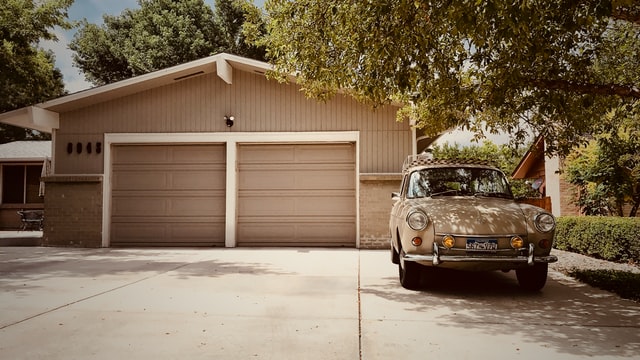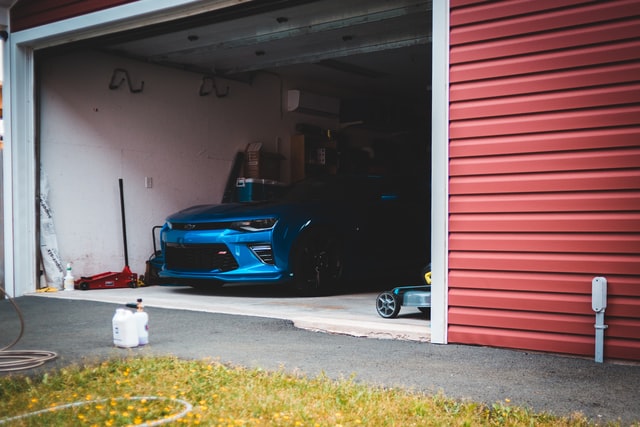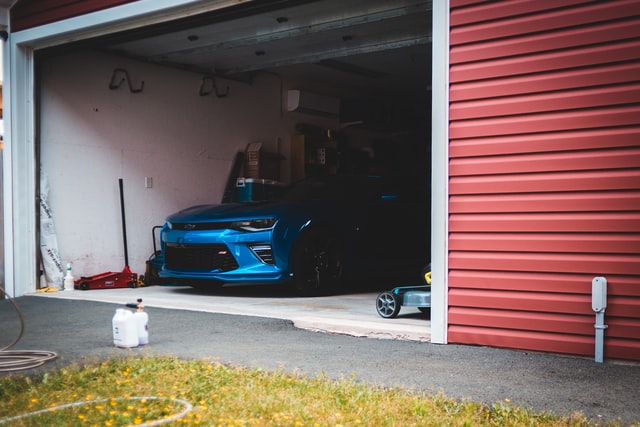Have you ever had this happen to you? You go away on holiday, or it’s the weekend and life is busy so you go shopping. Then, you come back and find that your car has been clamped from being parked. You didn’t see the funny yellow lines and left your car there. Or maybe it was an event that everyone went to without checking parking restrictions. Either way, it happens, and it sucks when you get a fine on top of everything. This is just one example of what can happen if your car sits in the same spot for too long without moving.
So, how can we manage this car idle trouble? Will you ever use your car again? Let’s find out!
HOW TO PREVENT YOUR CAR FROM HAVING DAMAGED WHILE PARKED

Before jumping to our main topic, let’s first discuss how to prevent your car from acquiring damage when parking for too long.
Cover your steering wheel.
The steering wheel is a big target for damage, especially in cold weather. It can be difficult to protect your car while parked if you don’t have a cover handy. Try these alternatives instead:
Use a plastic bag. Wrap your steering wheel with a towel. Then, put down an old pillow or blanket over the entire seat, including the area where your lap would normally rest as well as under your legs. After that, put on an extra hoodie before going out into the cold air. You can also place an old jacket over your seat (the kind of sports coat that some men might wear at night). Lastly, tuck in any shirts you have hanging around that are too long for everyday wear but still work for this purpose (and will keep things tidy).
Put your driver’s seat back.
What you may not know is that the most common cause of damage to your car, while it’s parked, is something as simple as a sunshade. Unfortunately, there’s no way to prevent this from happening if you’re in a position where it’s appropriate for your seat back to be up or down. What we recommend instead is using a sunshade every time you park outside, regardless of what position your seat is in.
Remove something from your keychain.
Remove any sharp objects from your keychain. You can also remove any keys that are not used regularly. If you have unnecessary keys on your keychain, don’t let them chained together with your car keys. Instead, put them in a safe place so they don’t get lost.
Remove any unnecessary keys from your car’s ignition. Get rid of all unnecessary keychains, rings, fobs, and whatever else is hanging off of the keyring itself. This will help prevent damage to the ignition cylinder when trying to start the car by jamming it up with extra weight!
Use a sunshade.
A sunshade is the best accessory to protect your car from the sun. They can be bought in many different colors, sizes, and styles. There are also a wide variety of manufactured materials that sunshades are made out of. Some people prefer cloth as it is easier to clean, but some others prefer vinyl because it does not require any deep cleaning at all. The most important thing about using a sunshade is actually installing it on your car’s windshield so that no one else can see inside your vehicle while you’re parked at home or work.
Get rid of the pet hair.
If you are a pet owner and love to bring them on every ride, your car may possibly have lots of pet hair that can damage your car while parked. Here are the ways to clean it.
>>Use a lint roller.
This is probably the most general way to get rid of pet hair. It’s also the easiest and most effective way, especially for small amounts of hair. Simply roll over your seats, carpets, and mats with the lint roller, picking up any loose hairs as you go along.
>>Use a vacuum cleaner to clean out car vents.
This can be hard work if you don’t have an attachment specifically made for cleaning out car vents. If your vacuum looks like it without an attachment fitted onto it, simply take off any attachments that are attached to its base and replace them with one that has a long hose on it.
Then use this new attachment connected to the end of your existing power cord in order to reach all areas within your vehicle’s air vents where dirt may have accumulated over time. Dirt may be stuck due to regular wear-and-tear caused by driving around town day after day while parked outside where there’s always wind blowing against them while parked outside near trees which occasionally shed leaves onto vehicles as well as other cars passing by at high speeds.
>>Other environmental issues
Sometimes, environmental events may hit yours causing damage from rocks flying off tires hitting windshields making tiny cracks which turn into larger ones when windshield wipers sweep across them allowing water inside causing mold growth causing more damage than just having no ventilation system installed at all!
Turn off your interior lights.
If you are planning to idle your car or leave it unused for a long time, don’t forget to turn off your interior lights, the lights in the back of the car, your map lights and dome light, or use a dimmer switch to turn down their brightness.
Make sure all of your gauges are turned off or display zero miles per hour. This helps prevent thieves from noticing that you have left it running while parked on a street or in an empty parking lot.
You can also pop open a window slightly so that air is circulating inside, which makes it harder for someone to tell if they’re breathing in exhaust fumes while conducting their reconnaissance mission. Lastly, be sure to turn off headlights, taillights, and brights as well (if available).
Clean up any crumbs and remove the trash.
Before leaving your car, clean up any crumbs and remove the trash. Check for the ashtray, if you’re smoking, and clean it out. If you have a glove compartment, don’t skip that!
Clean out the trunk if you have one, or at least remove anything that’s loose in there so it doesn’t damage your car when it gets jostled around as you drive along (this includes things like umbrellas).
Get into the back seat with a vacuum cleaner or broom and give it a thorough cleaning; this is important because most people don’t think about how dirty their cars can get while they’re parked on busy streets or in lots full of other cars.
Put a barrier between the seats and back of the car.
You can use a towel or any covering to protect the seats. If you have a towel, fold it over and secure it with a piece of duct tape. You can use this as an area to sit down on during long drives that won’t get dirty or wet.
If you do not have a seat cover, purchase one online or at your local hardware store. Most seat covers are uncomplicated to install and will fit perfectly in your car’s seats. Seat covers come in many extra colors and designs so there is sure to be one for every taste! They are also affordable so anyone can afford them without breaking their budget!
Put a cover on the car seat or put things on the seat to prevent damage to the covers or leather.
The last note to do before leaving your car is to make sure that nothing is exposed. Put a cover on the car seat or put things on the seat to prevent damage to the covers or leather.
As mentioned, you can use a towel or blanket (which should be in the trunk of your car) to put over your car seat. Not only in your driver’s car seat but also on the back seat and the bottom of your car seats, if necessary.
WHAT WILL HAPPEN IF YOU LET YOUR CAR UNUSED FOR A LONG TIME?

When a car sits unused for a long period of time, it starts to break down.
To keep your car in good shape for as long as possible, you should drive it at least once a week. If you’re going to travel for more than two weeks and won’t be using your car during that time, disconnecting the battery is recommended to preserve its charge.
I recommend leaving cars unused for no more than three months tops, any longer than that and they start breaking down faster than normal (which can lead to rust damage). If you’re storing your car somewhere where it’s safe from thieves or other damage, there’s nothing wrong with leaving it parked indefinitely. Just make sure to check everything periodically so nothing breaks down too much while parked away from use.
A tire will lose pressure over time, corrode and become unbalanced.
The longer your car is parked, the more likely it will be to lose pressure in its tires. That’s because the tire itself will begin to corrode. The rubber in a tire is highly susceptible to moisture and can degrade quickly in the presence of moisture. This means that even when you’re not driving your vehicle for a few days at most, your tires are still losing air and becoming unbalanced from one another.
Another thing that happens as you park your car for long periods of time is that the tires start wearing out more quickly than usual due to uneven weight distribution over time, which makes them more prone to blowouts when you finally do decide to drive again!
Excess moisture will settle in the car’s fluid lines, the oil will build up sludge and the gasoline will begin to degrade.
Excess moisture will settle in the car’s fluid lines, the oil will build up sludge and the gasoline will begin to degrade. The result is that you’ll have to deal with a host of problems when you start up your car again. You could end up having to replace parts or even entire engines as well as pay for expensive repairs.
To prevent this from happening, make sure that your vehicle is parked in an area where it won’t be exposed to precipitation. If you can’t avoid it, make sure that there are no leaks on your windshield or windows so they don’t get wet if it rains while you’re not using your car. Also, keep away from puddles or other sources of water so they don’t collect around them when they’re moving through those areas and cause damage while they’re parked at home or work!
If you’re going to be gone for more than two weeks, consider disconnecting your battery to preserve its charge.
If you’re going to be gone for more than two weeks, consider disconnecting your battery to preserve its charge.
This is a fairly straightforward process: open the hood of your car and locate the battery. Unplug it from its terminals (there will be two metal posts on either side of it), then close up the hood again before moving on with your day.
When reconnecting your battery after more than two weeks’ absence, be sure to follow these steps in reverse order. First, reconnect one terminal at a time; if possible, use an assistant to help hold down each terminal while you connect it with their corresponding post on the vehicle’s side or top edge (depending on which side of their respective posts are marked “+” or “-“). All that’s left after this final step is closing up your car’s hood once again and starting up!
When you take a long trip and park your vehicle overnight at a hotel, keep the windows cracked slightly open during your stay.
When you take a long trip and park your vehicle overnight at a hotel, keep the windows cracked slightly open during your stay. This practice allows air to circulate in the car, thus preventing moisture from collecting inside. It also helps prevent the car from getting too hot or cold.
It’s good to leave your vehicle parked outside during hot summer months as well as colder winter ones. If your vehicle sits outside without moving for extended periods of time in extremely hot or extremely cold temperatures, it may overheat or freeze up (or both), which could cause damage to the engine and other parts of your car that aren’t designed for those conditions.
If you must leave your vehicle parked for more than a few months without starting it up periodically, use a trickle charger or battery maintainer on the battery to keep it charged.
If you must leave your vehicle parked for more than a few months without starting it up periodically, use a trickle charger or battery maintainer on the battery to keep it charged. An uncharged car can become damaged by freezing temperatures or corrosion in the engine compartment.
If you live in an area where there is severe winter weather and are planning to store your vehicle for an extended period of time, use these tips:
- Keep all fluids topped off before storing your car and do not add anything new to them during storage. Use only non-ethanol gas if possible (some areas will not sell regular unleaded fuel because of its high cost).
- Fill up with regular unleaded 91 octane gas just before driving off into storage; this way you won’t have problems with old fuel potentially gumming up any parts inside your engine if you need to start right away when spring arrives again!
WHEN DOES A CAR ACQUIRE DAMAGE FROM PARKING WITHOUT MOVING
It’s always a good idea to try and avoid leaving your car parked for longer than 2 weeks at a time. The longer you leave it unused, the more likely it is that something will go wrong with it. For example, if a vehicle sits in one place for too long without being driven, its tires can lose pressure and become unbalanced. This means that they won’t be able to grip the road properly when you eventually drive your car again – which could lead to an accident or injury!
Your car’s engine needs to move around frequently so that all of its parts stay lubricated and don’t rust or corrode away. If your vehicle isn’t used often enough (or at all), then this process won’t happen as quickly as it should do – leading to more corrosion over time
BOTTOM LINE
So remember, if you have to go car park for a little too long, at least now you won’t be doing it in vain. Aside from just leaving your car in your garage or in front of your facade, it’s also important to know how to park. Be creative when it comes to parking your car. This could be with the positions you choose, or simply making small changes to your current routine. With a bit of imagination and a little bit of effort, you’ll soon be racking up more miles than the average driver, and getting a better workout in the process!
If you’re done with parking, check the next article about car distancing by clicking here!

